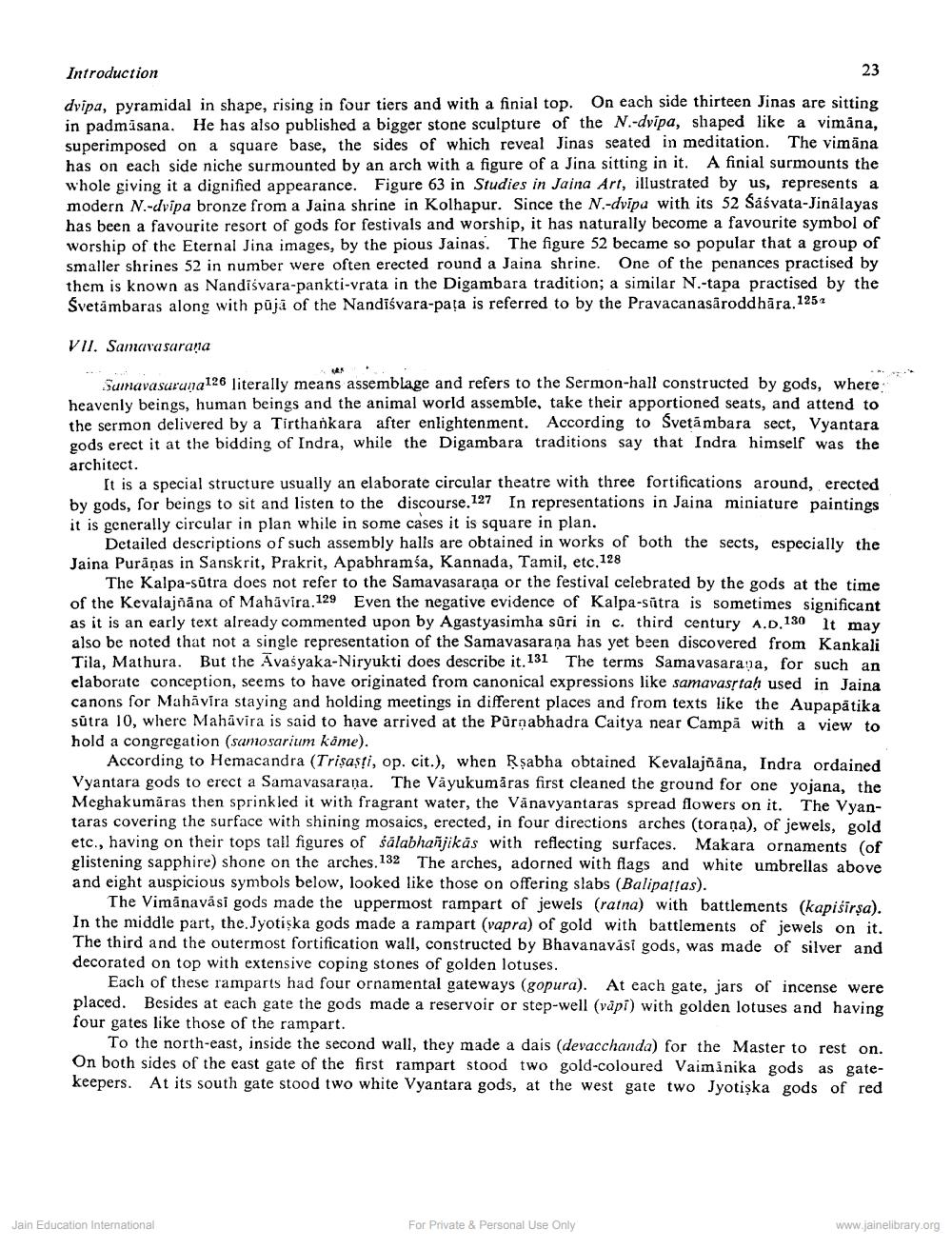________________
Introduction
23 dvipa, pyramidal in shape, rising in four tiers and with a finial top. On each side thirteen Jinas are sitting in padmisana. He has also published a bigger stone sculpture of the N.-dvipa, shaped like a vimana, superimposed on a square base, the sides of which reveal Jinas seated in meditation. The vimāna has on each side niche surmounted by an arch with a figure of a Jina sitting in it. A finial surmounts the whole giving it a dignified appearance. Figure 63 in Studies in Jaina Art, illustrated by us, represents a modern N.-dvipa bronze from a Jaina shrine in Kolhapur. Since the N.-dvipa with its 52 Sáśvata-Jinalayas has been a favourite resort of gods for festivals and worship, it has naturally become a favourite symbol of worship of the Eternal Jina images, by the pious Jainas. The figure 52 became so popular that a group of smaller shrines 52 in number were often erected round a Jaina shrine. One of the penances practised by them is known as Nandiśvara-pankti-vrata in the Digambara tradition; a similar N.-tapa practised by the Svetambaras along with pūjā of the Nandiśvara-pața is referred to by the Pravacanasäroddhāra. 1252
VII. Samarasarana
Sumavasuruna126 literally means assemblage and refers to the Sermon-hall constructed by gods, where heavenly beings, human beings and the animal world assemble, take their apportioned seats, and attend to the sermon delivered by a Tirthankara after enlightenment. According to Svetambara sect, Vyantara gods erect it at the bidding of Indra, while the Digambara traditions say that Indra himself was the architect.
It is a special structure usually an elaborate circular theatre with three fortifications around, erected by gods, for beings to sit and listen to the discourse. 127 In representations in Jaina miniature paintings it is generally circular in plan while in some cases it is square in plan.
Detailed descriptions of such assembly halls are obtained in works of both the sects, especially the Jaina Purăņas in Sanskrit, Prakrit, Apabhramśa, Kannada, Tamil, etc. 128
The Kalpa-sutra does not refer to the Samavasarana or the festival celebrated by the gods at the time of the Kevalajnana of Mahävira. 129 Even the negative evidence of Kalpa-sätra is sometimes significant as it is an early text already commented upon by Agastyasimha sūri in c. third century A.D. 130 lt may also be noted that not a single representation of the Samavasara na has yet been discovered from Kankali Tila. Mathura. But the Avasyaka-Niryukti does describe it.131 The terms Samavasaraya, for such an elaborate conception, seems to have originated from canonical expressions like samavasstah used in Jaina canons for Mahavira staying and holding meetings in different places and from texts like the Aupapātika sūtra 10, where Mahavira is said to have arrived at the Puraabhadra Caitya near Camp, with a view to hold a congregation (samosarium kame).
According to Hemacandra (Trişasti, op. cit.), when Rşabha obtained Kevalajñāna, Indra ordained Vyantara gods to erect a Samavasarana. The Väyukumāras first cleaned the ground for one yojana, the Meghakumaras then sprinkled it with fragrant water, the Vănavyantaras spread flowers on it. The Vyantaras covering the surface with shining mosaics, erected, in four directions arches (torana), of jewels, gold etc., having on their tops tall figures of salabhanjikās with reflecting surfaces. Makara ornaments (of glistening sapphire) shone on the arches. 132 The arches, adorned with flags and white umbrellas above and eight auspicious symbols below, looked like those on offering slabs (Balipatsas).
The Vimanavasi gods made the uppermost rampart of jewels (ratna) with battlements (kapiširşa). In the middle part, the.Jyotiska gods made a rampart (vapra) of gold with battlements of jewels on it. The third and the outermost fortification wall, constructed by Bhavanavasi gods, was made of silver and decorated on top with extensive coping stones of golden lotuses.
Each of these ramparts had four ornamental gateways (gopura). At each gate, jars of incense were placed. Besides at each gate the gods made a reservoir or step-well (väpi) with golden lotuses and having four gates like those of the rampart.
To the north-east, inside the second wall, they made a dais (devacchanda) for the Master to rest on. On both sides of the east gate of the first rampart stood two gold-coloured Vaimånika gods as gatekeepers. At its south gate stood two white Vyantara gods, at the west gate two Jyotiska gods of red
Jain Education International
For Private & Personal Use Only
www.jainelibrary.org




